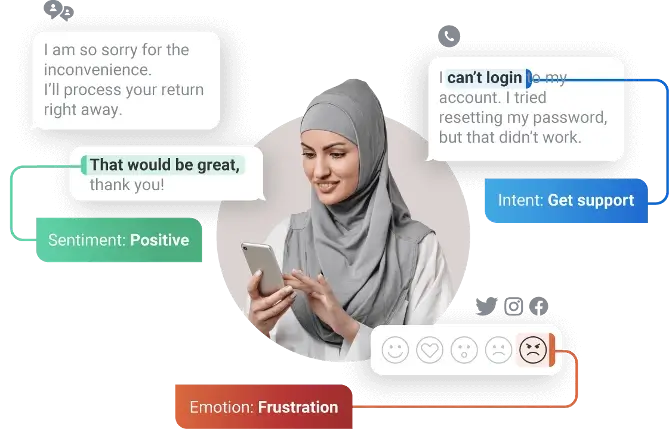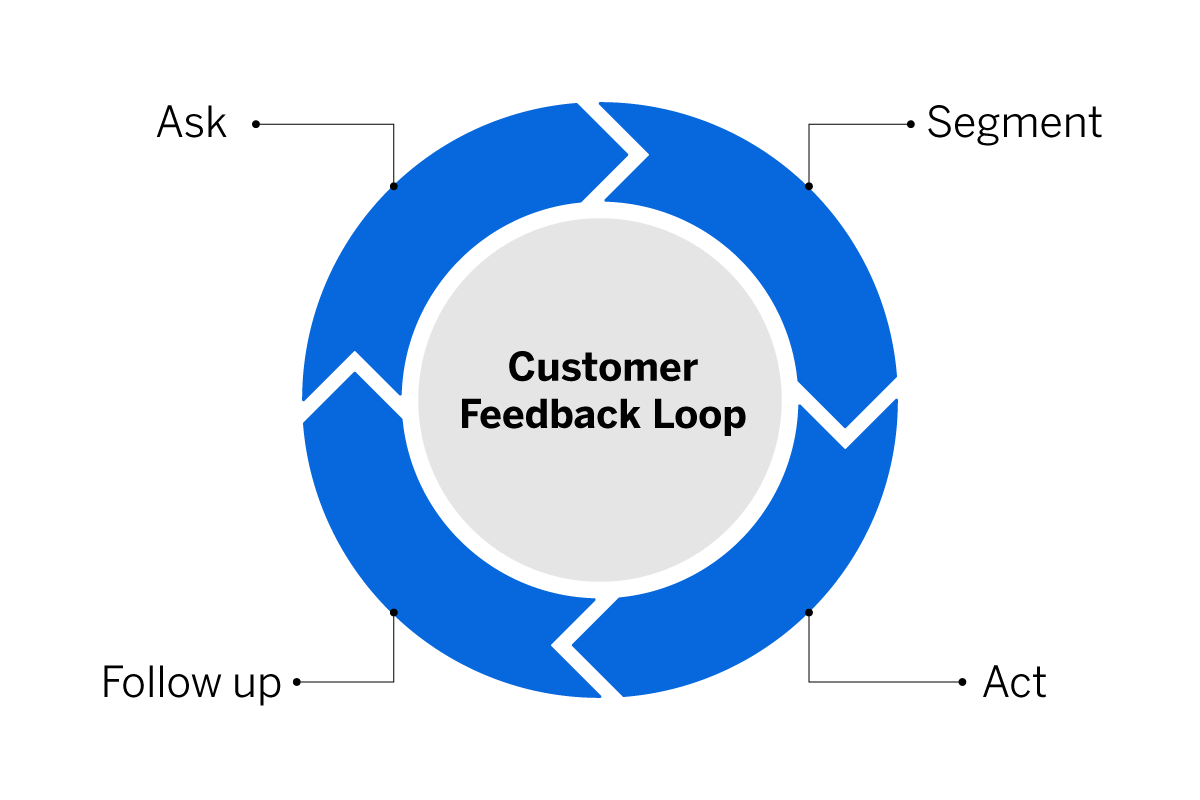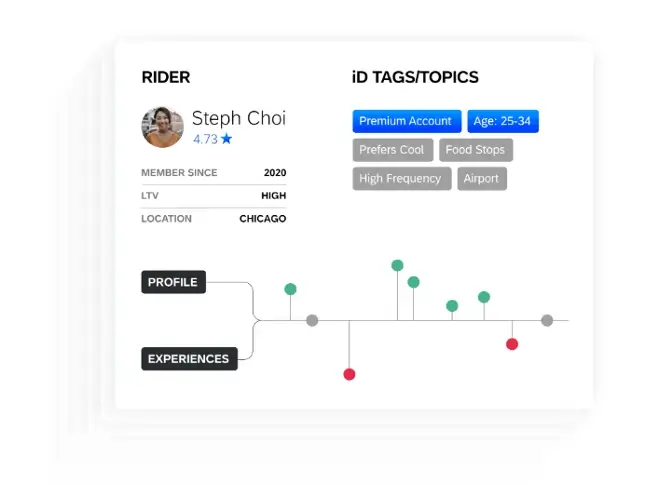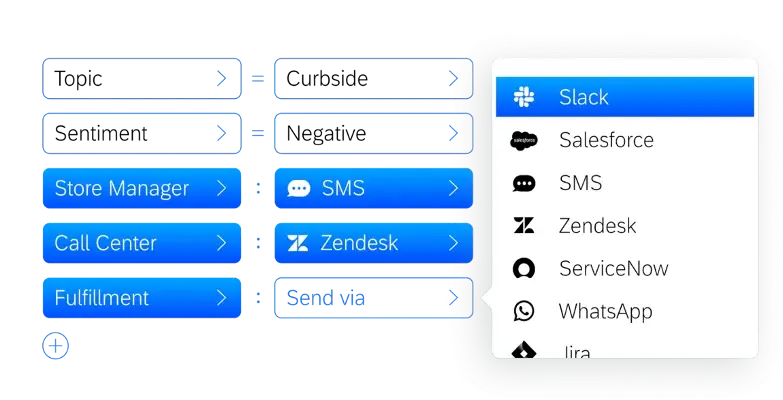Written by: Rosemin Anderson
Subject matter expertise by: Dave Pabley
What is customer sentiment?
The customer sentiment metric helps organizations to pinpoint customer opinions and feelings about their business, products or services. It allows companies to see if their audience has a positive, negative or neutral view of their experiences.
Sometimes referred to as “user sentiment”, customer sentiment can be a great indicator of issues in your experiences or service, providing an excellent starting point for action. Customer sentiment analysis of live chat, telephone call transcripts and other data inputs from customer interactions can not only provide insights for future change, but help with decision-making in real time.

When used in conjunction with analysis of customer emotion, intent and effort, customer sentiment scoring is a very useful tool for providing better experiences and customer support.
But how is customer sentiment scored, and how can businesses focus on driving action from customer sentiment analysis?
Free Guide: Reimagining omnichannel CX in the age of AI
What is customer sentiment analysis and how does it work?
Customer sentiment analysis is the examination of your customers’ thoughts and feelings about your brand and the interactions they have with your organization. Using conversation analytics software, you can collect and track feedback, monitor interactions, analyze customers’ commentary for sentiment insights and deliver appropriate responses in near real time to your team.
Customer sentiment software uses computational linguistics, such as Natural Language Processing (NLP) or Natural Language Understanding (NLU), to apply machine learning to text and extract insights.
Tracking customer sentiment across multiple channels can be an overwhelming task for human staff – but NLU automates this process, pulling data from touchpoints and transforming it into useful prompts for action.
Continue reading to understand the ROI of customer sentiment analytics, how to complete it and the strategies for improving customer sentiment.
Benefits of customer sentiment analysis
You can better understand your customers’ needs and expectations
Typical metrics used to measure customer’s preferences and opinions – CSAT, NPS and CES, for example – are incredibly useful, but they are lagging quantitative metrics. Customer sentiment, in contrast, can be used in near-real time as a qualitative customer service metric, which can be a leading indicator of critical issues requiring attention.
It’s also connected to almost all your other measured metrics – if your customers have negative sentiments, they’re almost certainly not feeling satisfied, are unlikely to recommend you to others, and consider your experiences high-effort. With 8 out of 10 people believing customer experiences need to be improved, it’s critical to find and resolve the drivers of churn to retain customer loyalty.
With insights from customer sentiment, you can find out why your customers are or aren’t happy directly from them in their own words. Customer sentiment analysis takes the voice of the customer and examines it for deeper meaning, giving you unrivaled insights into your customers’ feelings, motivations, and opinions.
You can resolve problems before they affect your bottom line
Our research has found that across the world, organizations risk 6.7% of their revenue (an alarming $3.1 trillion) when customers are lost due to bad experiences. However, by driving action from customer sentiment, businesses are able to tackle bad experiences as they happen and transform them into opportunities for neutral or positive sentiment.

Our research shows that 36% of consumers are unhappy with the empathy shown in their customer service interactions. With sentiment analysis tools such as Agent Assist, you’re able to handle instances of negative sentiment and show empathy more effectively. Rather than applying a one-size-fits-all approach to handling a customer’s bad experience, your customer support agents are able to understand customer interactions in more depth and act accordingly to reduce churn.
You’re able to better train your staff to handle dissatisfied customers
Customer sentiment analytics is an ongoing way in which you can better train your staff. With the power of AI and machine learning, prioritizing customer issues and complaints for severity and handling them appropriately becomes easier. When you track customer sentiment, you’re also able to mark trends over time – meaning you can inform your teams when particular trends are likely to occur (for example, negative sentiment after a service discontinuation). Handling dissatisfied customers becomes easier with increased knowledge about how customers feel.
You can generate more revenue by retaining valuable customers
When customers have great experiences, they’re more likely to become loyal customers. Customers who rate an experience 5/5 stars are more than twice as likely to repurchase, with 80% of satisfied consumers increasing their spending. Transforming neutral sentiment or negative sentiment during key touchpoints (such as contact center calls) can help to build a reputation of trust for great experiences and generate further revenue.
You improve your brand reputation and draw in new customers
The sentiment behind your customers’ views can drive positive and negative brand reputation. Finding and fixing negative brand sentiment can greatly improve your business’ chances of being recommended.
For example, 92% of global consumers trust earned media such as recommendations from friends and family above all other advertising types. By tackling negative sentiment when and where it happens, you’re able to encourage your customers to spread the good word for a better brand reputation.
Free Guide: Reimagining omnichannel CX in the age of AI
How to measure customer sentiment
Here is a blueprint for measuring customer sentiment, from choosing your sentiment analytics tools to forming your customer sentiment score.
- Invest in customer sentiment analytics software and collate your data
It’s important to invest in customer sentiment analysis tools that can source, collate and analyze your customer data in one centralized location. This helps you to break down team silos and avoid losing important insights cross-department.
You’ll also need software that is sophisticated enough to source data from multiple sources. The benefit of tracking customer sentiment with in-depth analytics software means that you can apply your analysis to calls, chats, emails and many other locations where customer data can be mined. Rather than just relying on customer feedback that comes to you some time after sentiment-forming experiences have happened, you can find information right in the moment with the right tools.
- Create sentiment scores
Fine tuning sentiment scoring may be an ongoing process, but developing a sentiment score for interactions can help you in pinpointing how customers feel more accurately.
For example, labeling customer comments as positive, negative or neutral in sentiment can be useful, but adding a further aspect – the intensity of feeling – can be even more indicative of how customers feel.
A very positive comment, for example, could be labeled “+2”, a neutral comment “0” and a very negative comment “-2”. A mildly positive comment could be “+1”. With the right sentiment analytics in place, the technology should be able to handle this for you and provide you with even deeper insights.
- Monitor third-party sites such as social media channels and review sites
Your analytics platform should be able to monitor multiple channels for information that could be pertinent to each customer’s sentiment score. With Natural Language Understanding (NLU) in place, you can transform social media comments and third party reviews into customer data for your sentiment score. Your analytics tool should also be able to take into account more structured metrics, such as average star rating, and compile these results into a cohesive overview with sentiment in mind.
- Request feedback from customers
You can send detailed surveys with open text fields post-interaction to gather feedback from customers that can then be evaluated for customer sentiment. CSAT surveys are frequently used to judge how satisfied customers were with their experience, but they can also be mined for valuable data on customer sentiment. This can assist your team in segmenting your audience more effectively for better targeting down the line.

- Determine pain points and sentiment drivers
By using sentiment analytics on all customer interactions – from customer service chats to review comments – you can begin to see trends that highlight pain points and drivers of sentiment. Increasing negative sentiment in product reviews, for example, might flag a user experience issue or a product problem.
With your customer data pulled into one platform for analysis, you can collate insights to answer questions such as:
- Which products/services/features drive positive sentiment?
- Which interactions cause the most negative sentiment?
- How can neutral sentiment be transformed into positive sentiment?
- What actions best transform negative sentiment to positive sentiment?
- Take action
Once you’ve understood how customers feel about your products and services and you have identified pain points and areas of friction, you can take action to improve. Whether that’s implementing new customer service scripts, changing product designs, redoing the customer website experience or more, you can actively target the areas in which your customers are unhappy and cultivate positive sentiment.
How to improve customer sentiment
- Look at trends over time and make predictions
Your customer sentiment analytics software will help you to understand pain points and trends and make predictions for future disruptions.
For example, if customer sentiment tends to dip when product prices change, you can provide your customer service team with prompts to handle it more effectively. You can also pre-empt the drop by targeting your marketing at the segments most likely to feel negatively about this change. Understanding customer expectations helps to drive agent empathy and improve your products and services in line with what customers want.
- Utilize your customer sentiment analytics software to send instant insights to your team
Your sentiment analysis tools should be able to provide instant notifications and insights to your various teams. With these insight capabilities, changes can be made in real-time to address negative sentiment and improve the customer likelihood to recommend.
- Train your staff with proven strategies
Your employees are best positioned to turn negative sentiment around and transform bad experiences into positive ones. With real-time analysis of sentiment, there’s the opportunity to guide agents as they interact with customers, providing on-the-job training for each specific customer circumstance.
Selecting your customer sentiment analytics software
Customer sentiment analytics software should be able to effortlessly collect and analyze instances of sentiment expression, driving change across your business.
Your customer metric analytics software should be able to:
Bring all your analytics into one platform
Customer sentiment isn’t the only metric you’ll need to monitor if you want to understand your customers in better detail. You’ll need analytics software that can scan multiple channels and bring insights into one platform, complete with dashboards that make it easy to share information with your teams.

Build comprehensive profiles
Your customers are continually providing you with information about themselves, their wants and their needs. Honing in on how best to target them for marketing and sales means having all their details in one place. More than just demographic information, these profiles should have information on past history with your brand, their sentiment scoring, their behavior and more.

Blend seamlessly into your current tech ecosystem
Your customer sentiment analytics software should be a cornerstone in your tech ecosystem, being able to analyze information drawn from multiple channels. It should also be able to deliver information and suggested actions using the current software stack that the brand uses to minimize disruption and maximize efficiency.

Creating great experiences on every channel
The Qualtrics approach can turn your customer experiences into your brand identifier, driving positive customer sentiment and transforming bad experiences into great ones. Understand how to create a truly memorable omnichannel customer experience with our latest publication, Reimagining Omnichannel CX, backed by detailed research into customer sentiment.
Free Guide: Reimagining omnichannel CX in the age of AI